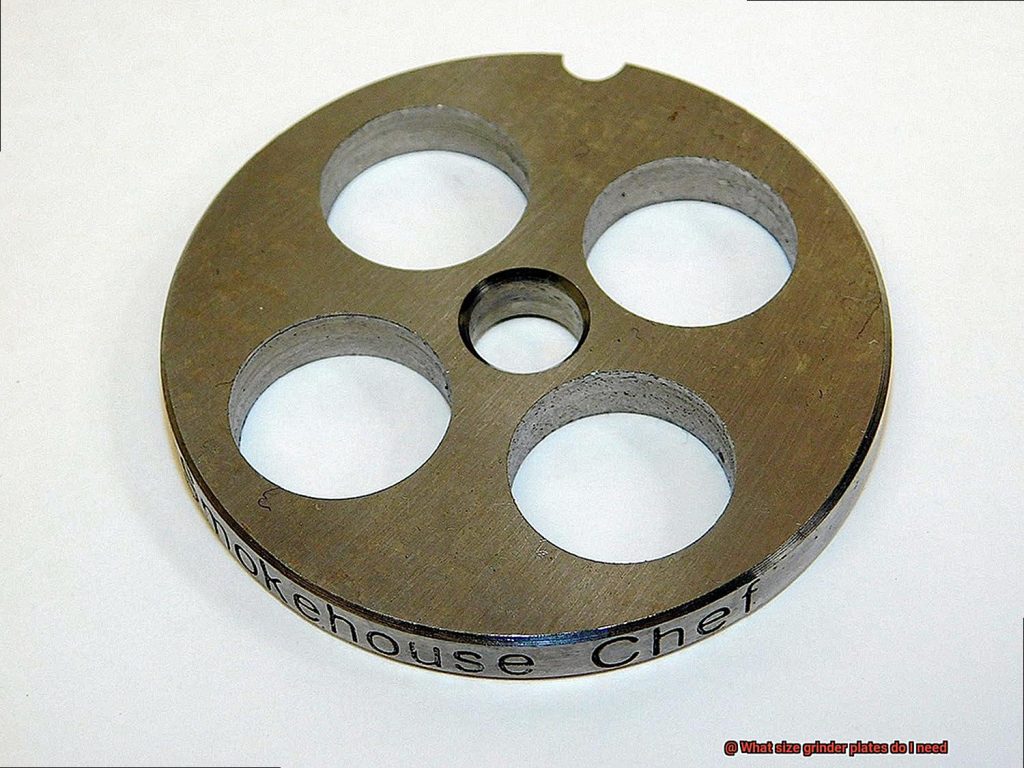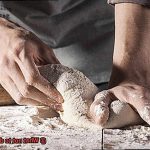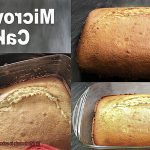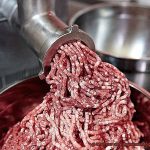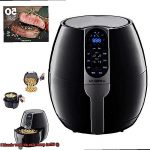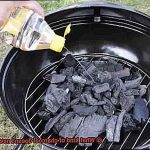Are you a meat lover looking to take your culinary skills to the next level? Do you want to create your own signature sausages or burgers with the perfect texture and flavor? If so, then understanding the importance of grinder plates is crucial.
Grinder plates are the unsung heroes of meat grinders. They come in various sizes, each with a unique purpose that determines the coarseness or fineness of the meat grind. Whether you’re making sausages, burgers, pâtés, or meatballs, choosing the right size grinder plate is essential for achieving the desired result.
So, what size grinder plates do you need? It all depends on your specific application. For finer grounds like sausages and pâtés, smaller plates with holes ranging from 3/16 to 1/4 inches are ideal. Meanwhile, larger plates with holes measuring 1/2 inches and above are best for coarser grinds like burgers or stuffing sausages.
In this blog post, we’ll dive deep into what size grinder plates you need for different types of meats and dishes. We’ll also explore the various options available in the market and provide tips on how to make an informed choice for your grinding operations.
So roll up your sleeves and get ready to grind. With our expert advice on hand, you’ll be whipping up mouthwatering homemade meats in no time.
Contents
What is a Grinder Plate?
The humble grinder plate plays a crucial role in grinding meat into different sizes and shapes. Made of stainless steel, grinder plates are durable and long-lasting, with various sizes and hole diameters ranging from 3/16 inch to ½ inch, depending on your specific needs.
The size of the grinder plate is determined by the diameter of the holes in the plate. Smaller holes produce a finer grind, while larger holes create a coarser texture. Depending on the type of meat and texture desired, different plate sizes may be appropriate. For example, lean meats like chicken or turkey require a smaller plate size to achieve a finer texture, while fattier meats like beef or pork require a larger plate size to grind the fat and meat together for a juicier end product.
It’s important to choose a grinder plate that is compatible with your specific type and brand of meat grinder. Using the wrong size plate can result in poor-quality ground meat or even damage to your grinder. Before making a purchase, refer to your grinder’s instruction manual or consult with an expert to determine which plate size and coarseness are best for your specific needs.
In addition to size, grinder plates may also be labeled with a number or letter code indicating the coarseness of the grind. A plate labeled “10” will produce a finer grind than a plate labeled “22”. It’s important to refer to your grinder’s instruction manual or consult with an expert to determine which plate size and coarseness are best for your desired dish.
Factors to Consider When Choosing a Grinder Plate Size
Grinding meat is a culinary art that requires precision and attention to detail, and choosing the right size grinder plate is an essential step in the process. As an expert in this field, I have compiled a list of factors to consider when selecting grinder plate sizes to help you create the perfect texture and flavor for your ground meat dishes.
Firstly, the type of meat you will be grinding is a crucial factor to consider. Different meats have varying levels of connective tissue, which affects the texture of the ground meat. For instance, beef and pork have more connective tissue, making them ideal for larger grinder plate sizes that produce a coarser grind. Conversely, chicken and turkey have less connective tissue, meaning that smaller grinder plate sizes are recommended to achieve a finer grind.
Secondly, the dish you intend to make plays a significant role in determining the appropriate grinder plate size. For chunkier dishes like burgers or meatballs, a coarser grind is recommended as it provides a more substantial texture. On the other hand, if you plan on making sausages or pâtés that require a smoother texture, a finer grind is preferred. Choosing the right size grinder plate for your intended dish enhances its flavor and texture, taking your culinary game to the next level.
Lastly, it’s essential to consider the size of your grinder when selecting a grinder plate size. Smaller grinders usually come with smaller plates while larger grinders come with larger plates. If you own a smaller grinder, it may be challenging to find larger plates compatible with it. Conversely, if you have a larger grinder, you have more options when it comes to choosing grinder plate sizes.
Choosing the Right Size for Lean Meats
It’s like selecting the right brush for painting, or picking the right shoe for running- it makes all the difference.
When it comes to lean meats like chicken or turkey, a smaller grinder plate with 1/8 inch or 3/16 inch diameter holes is ideal. This produces a fine texture that is easy to work with and perfect for making burgers or sausages. Using a larger plate could cause the meat to over-grind, resulting in a tough and chewy texture, which is not what you want. The key here is not to overwork the meat.
On the other hand, slightly fattier meats like beef or pork need a larger grinder plate with 1/4 inch or 3/8 inch diameter holes to handle the fat content. This will produce a coarser grind that’s great for making meatloaf or meatballs. The larger holes prevent the meat from becoming overworked, maintaining its tenderness.
The size of the grinder plate affects the texture and consistency of the ground meat directly. A smaller plate with smaller holes will produce a finer grind, while a larger plate with bigger holes will result in a coarser grind. You should experiment with different sizes to find what works best for you.
It’s worth noting that if you use a smaller plate on fattier meats, you might end up with an overly greasy texture. Similarly, if you use a larger plate on lean meats, they’ll become tough and dry. The balance between hole size and meat type is critical.
Choosing the Right Size for Fattier Meats
Grinding your own meat is the perfect way to achieve fresh, high-quality results that will impress even the most discerning palate. When it comes to grinding fattier meats like pork or beef, choosing the right size grinder plate is crucial. As an expert in this matter, I’m here to guide you through the process.
To begin with, the size of your grinder plate is instrumental in determining the texture and consistency of your ground meat. For fattier meats, a larger plate size is recommended to avoid overworking the meat and creating a tough texture. Moreover, a larger plate size allows larger chunks of fat to remain intact within the meat, resulting in a juicier and more flavorful finished product.
So how do you determine the right size grinder plate for your needs? A good rule of thumb is to select a plate with holes slightly larger than the size of the fat chunks in your meat. This will ensure that the fat is evenly distributed throughout the meat, giving you that mouthwatering texture that we all crave.
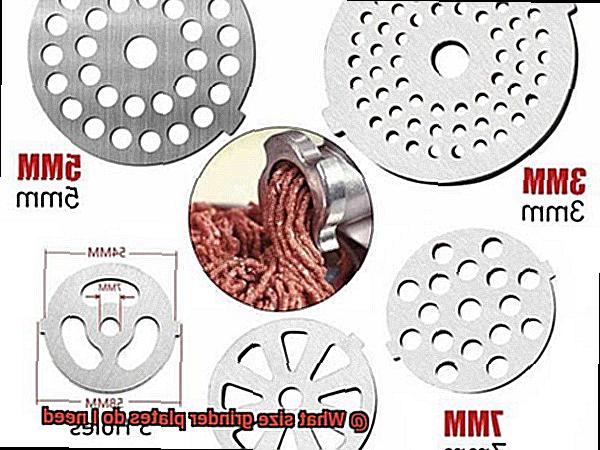
However, it’s important to note that a larger plate may not be suitable for leaner cuts like chicken or turkey. In such cases, using a smaller plate with finer holes will create a smoother texture and prevent overworking the meat, resulting in a moist and tender finished product.
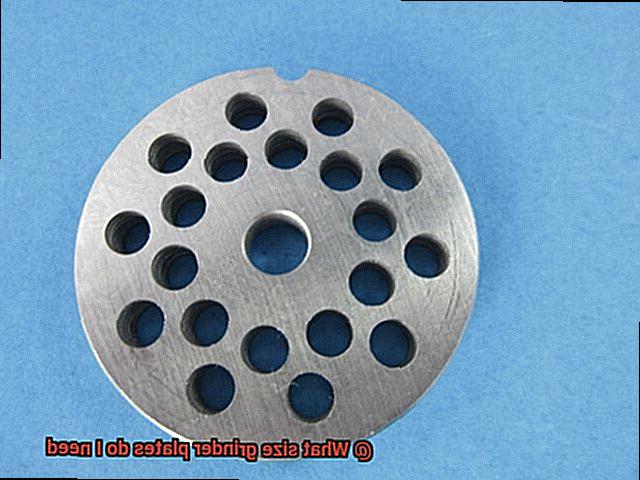
Coarser Grinds vs Finer Grinds
As an expert in meat grinding, let me give you the juicy details.
Coarser grinds result in larger chunks of meat, while finer grinds produce smaller pieces. This affects the texture of your end product, so it’s crucial to choose the right grind size based on the dish you’re making and your cooking method. Here are some factors to consider:
Type of Meat
The type of meat being ground is a major determinant of which grind size to use. If you’re making burgers with beef, a coarser grind may be preferable. The larger chunks of meat will give your patty a more textured surface and allow for a nice char on the outside while maintaining juiciness on the inside. For sausage or meatballs, a finer grind may be more appropriate as it allows for better mixing of the meat and spices.
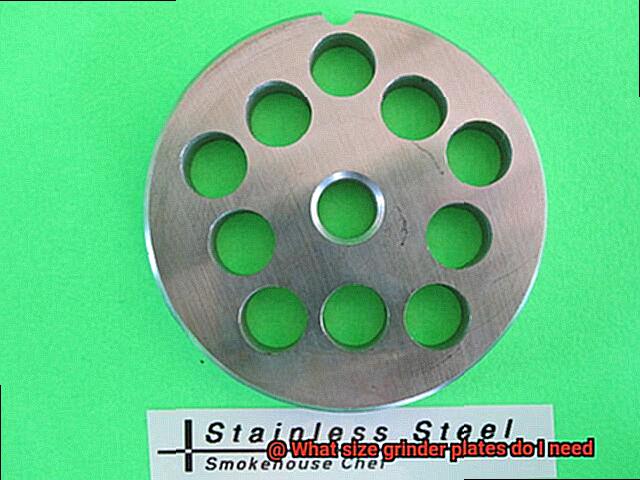
Cooking Method
Your cooking method also plays a role in deciding which grind size to use. Coarser grinds are ideal for grilling or broiling as they hold their shape better and allow for a juicy interior and flavorful exterior. Finer grinds are better suited for cooking methods such as pan-frying or baking as they cook faster and more evenly.
Grinder Plates
Different grinder plates have varying hole sizes, which correspond to different grind sizes. When selecting grinder plates, consider the desired end result and choose a plate with hole sizes that align with your preferences. A plate with larger holes will result in a coarser grind, while a plate with smaller holes will produce a finer grind.
Experimenting with Different Plate Sizes
Grinding meat isn’t just about throwing it into the grinder and letting it do its thing. Choosing the right size grinder plate can make all the difference in achieving the perfect texture and consistency for your dish.
Plate size directly affects the texture and consistency of the ground meat. A small plate size will give you a finer grind, perfect for burgers, while a larger plate size will give you a coarser grind, more suitable for sausages or meatballs. So, finding the right plate size is essential to get that perfect texture.
When experimenting with different plate sizes, it’s best to start small and work your way up. This allows you to find the perfect size without wasting a lot of meat. Start with a small plate size and see how it affects the texture. If it’s too fine or not suitable for your needs, move up to a larger size. Once you have determined the best plate size for your needs, you can then use it consistently to achieve the desired texture and consistency.
It’s also important to consider the type of meat you’re grinding when experimenting with different plate sizes. Tougher cuts of meat may require a larger plate size to achieve a desirable texture, while softer cuts of meat may need a smaller plate size. So, consider your meat type before experimenting with different plate sizes.
Feeding speed is another factor that can significantly affect the texture and consistency of ground meat regardless of the plate size used. So, experiment with different feeding speeds along with different plate sizes to find the perfect combination.
Tips for Finding the Perfect Grinder Plate Size
Grinding meat can be a game-changer for home cooks who want to take their dishes to the next level. However, the process of selecting the best grinder plate size can be overwhelming. To make things easier, here are some factors to consider:
Type of Meat
Different meats have different textures and fat content, so they require different plate sizes. For leaner meats like chicken or turkey, a smaller plate size is appropriate to prevent the meat from becoming too dry or tough during grinding. Fattier meats like beef or pork may benefit from a larger plate size that ensures an even grind and prevents clogging.
Intended Use
The size of your grinder plate will also depend on your intended use for the ground meat. If you’re making burgers or meatballs, a medium-sized plate with holes that are 3/16 inches in diameter will create the perfect texture for juicy and flavorful patties. However, if you’re making sausages or other processed meats, a smaller plate with holes that are 1/8 inches in diameter may be necessary to achieve the desired consistency.
Horsepower
When selecting a grinder plate size, it’s important to consider the horsepower of your grinder. A smaller grinder with less horsepower may struggle with larger plates, leading to uneven grinding and potential damage to the machine.
Experimentation
Don’t be afraid to experiment with different grinder plate sizes until you find the one that works best for your recipes. Trying out different sizes can help you find the perfect fit for your particular needs and preferences.
Seek Expert Advice
When in doubt, seek advice from a professional butcher or experienced home cook for their recommendations on the best size grinder plate for your specific needs. They may have valuable insights and tips based on their own experiences and expertise.
Xb55ew6_85Y” >
Conclusion
In the world of meat grinding, choosing the right size grinder plate is a make-or-break decision. It’s the difference between a melt-in-your-mouth texture and a tough, chewy mess. So, how do you know what size to choose?
Firstly, it’s important to understand that different meats require different plate sizes. Smaller plates produce a finer grind, while larger plates create a coarser texture. This means that if you’re grinding beef for burgers, you’ll need a different size plate than if you’re grinding pork for sausage.
But it’s not just about the meat type. You also need to consider your intended use and the horsepower of your grinder. Are you making meatloaf or meatballs? Do you want a smooth pâté or chunky chili? These factors will all affect which size plate is best for your needs.
Don’t be afraid to experiment until you find the perfect size for your recipe. After all, grinding meat is an art that requires precision and attention to detail. And if you’re feeling lost, seek expert advice from professionals who can guide you in the right direction.

